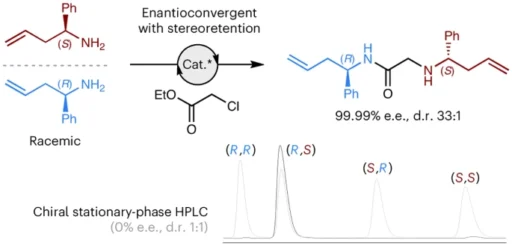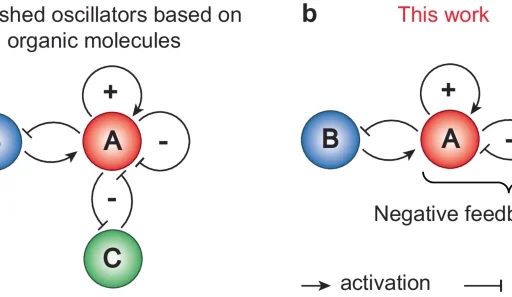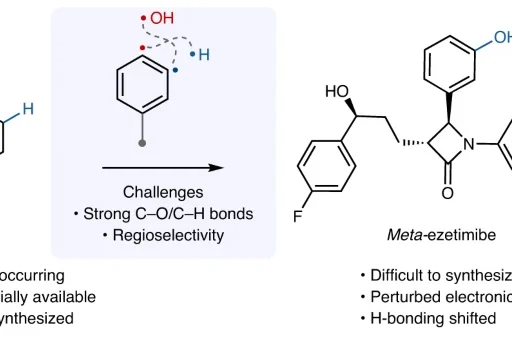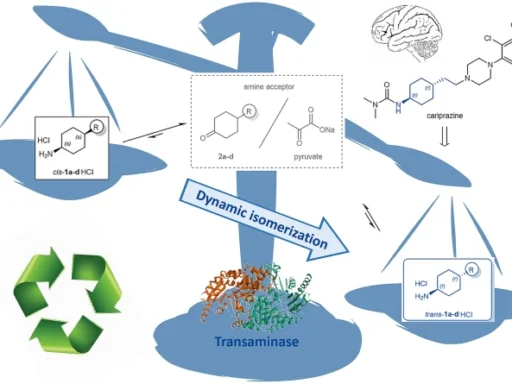Table of Contents
Overview of stereoretentive Reactions:
Efficient and sustainable synthesis procedures have always been a primary priority in the expansive field of organic chemistry. During this pursuit, stereoretentive enantioconvergent reactions have emerged as a captivating field of research, offering the potential for substantial progress in chemical synthesis. This article provides a detailed exploration of stereoretentive enantioconvergent reactions, focusing on their mechanics, uses, problems, and prospects.

An exploration of stereoretentive reactions:
their definition and significance:
Stereoretentive reactions are chemical processes that maintain the stereochemistry of the initial substance in the resulting product. The preservation of stereochemistry is critical for maintaining the intended molecular structure and characteristics, particularly in the production of intricate organic compounds. These stereoretentive reactions are crucial in contemporary organic synthesis since they enable the creation of complex molecular structures with precise control over their stereochemistry.
Categories of stereoretentive reactions:
The field of stereoretentive reactions comprises a wide range of chemical processes, each with distinct benefits and uses. These encompass asymmetric catalysis, dynamic kinetic resolution, stereospecific reactions, and more methods. Every reaction type utilizes unique processes and strategies to provide precise and selective stereochemical outcomes, accommodating various synthetic needs and difficulties.
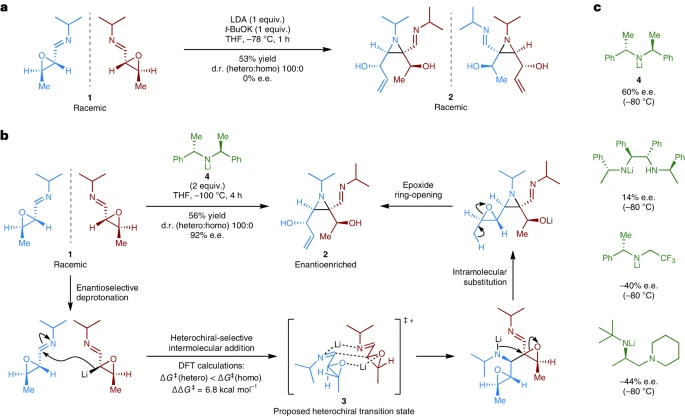
Enantioconvergent reactions:
What Are Enantioconvergent Reactions? Enantioconvergent reactions are chemical reactions that convert both enantiomers of a chiral compound into a single enantiomer.
Enantioconvergent reactions are a specific type of stereoretentive transformation where both enantiomers of a chiral starting material combine to produce a single enantiomerically enriched result. This convergence is accomplished by strategically designing catalysts or reaction conditions that allow for simultaneous conversion of both enantiomers with high selectivity and efficiency. Enantioconvergent stereoretentive reactions are significant in organic synthesis because they make stereoselective transformations quick and easy, and they let you use racemic starting materials without having to separate them, which can be expensive and take a lot of time.
Significance in Organic Synthesis:
Accessing enantiomerically enhanced molecules from racemic mixtures is crucial in chemical synthesis. One good way to reach this goal is through enantioconvergent reactions, which get around the usual problems of using chiral starting materials or isolating enantiomers. These stereoretentive reactions make it easier to make chemicals, reduce waste, and make chemical processes more effective and better for the environment by allowing the joining of both enantiomers into a single stereoisomer.
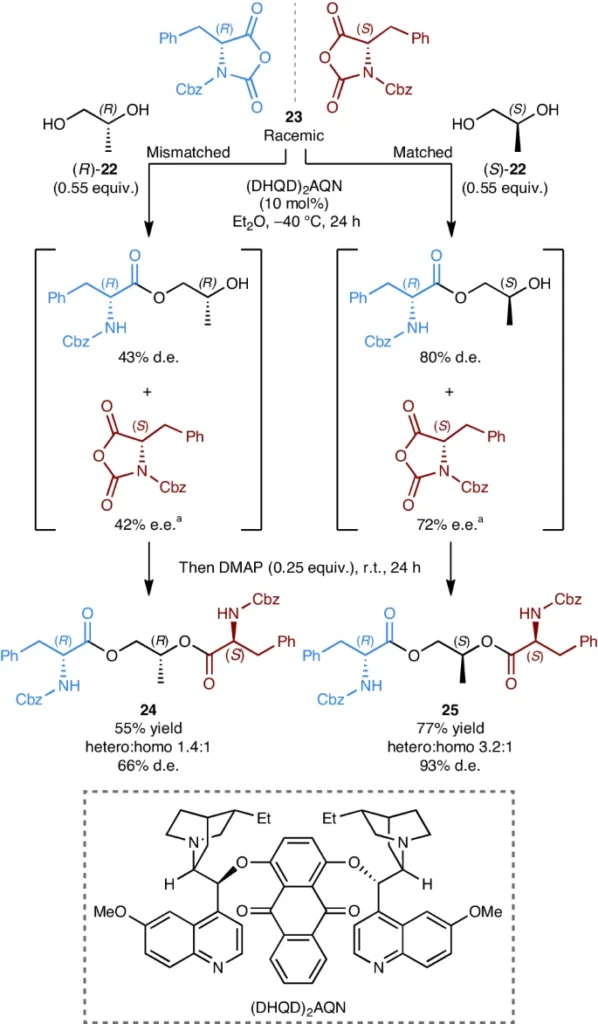
Obstacles and resolutions:
Exploring Difficulties Encountered in Stereoretentive Enantioconvergent Reactions:
Although stereoretentive enantioconvergent reactions have great potential, they nonetheless present certain problems. Substantial barriers to the successful application of stereoretentive enantioconvergent reactions may arise from challenges such as the range of materials available, the effectiveness of the catalyst, managing the stereochemistry, and the compatibility of the reaction. The basic objective of research on this topic is to design catalyst systems that are strong and specific, and capable of facilitating enantioconvergent conversions under gentle conditions.
Latest Innovations and Resolutions:
Recently, there has been notable advancement in tackling these difficulties and broadening the range of stereoretentive enantioconvergent reactions. Researchers have been able to overcome long-standing restrictions and attain unprecedented levels of stereocontrol and efficiency thanks to the discovery of new catalysts, unique reaction techniques, and powerful computational tools. Scientists have used asymmetric catalysis, supramolecular chemistry, and computer modeling to come up with new ways to make catalysts that are more active, selective, and tolerant of different substrates.
Software programs or computer applications:
Practical Uses of Stereoretentive Enantioconvergent Reactions:
Stereoretentive enantioconvergent reactions have a significant influence on various sectors and scientific fields, such as medicines, agrochemicals, materials science, and fine chemicals. Among other uses, these reactions produce physiologically active chemicals, natural products, chiral intermediates, and functional materials. Enantioconvergent reactions are crucial in various sectors of the economy, such as drug discovery, asymmetric synthesis, and chemical production. They allow for the efficient and selective construction of complex chiral compounds, promoting innovation and advancement.
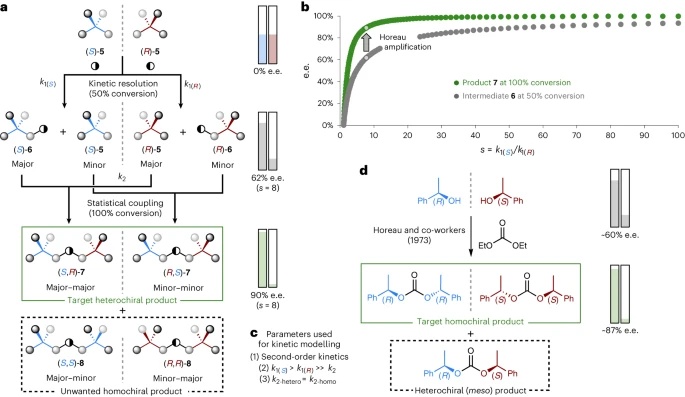
Prospects for the future:
Potential advancements and topics for further investigation are available:
Stereoretentive enantioconvergent reactions have a bright future ahead of them. More research is being done to increase the number of enantioconvergent transformations, make new catalytic systems, and better understand how reactions work. These efforts could lead to new ways of synthesizing chemicals and exploring them. The discipline is anticipated to undergo a revolution with advancements in computational chemistry, artificial intelligence, and high-throughput testing. These developments will allow for the swift design and optimization of catalysts and reaction conditions with unparalleled accuracy and efficiency. Furthermore, incorporating stereoretentive enantioconvergent reactions into automated synthesis platforms and flow chemistry systems has the potential to simplify synthetic workflows, expedite discovery timelines, and enable the efficient production of chiral molecules for a variety of applications.
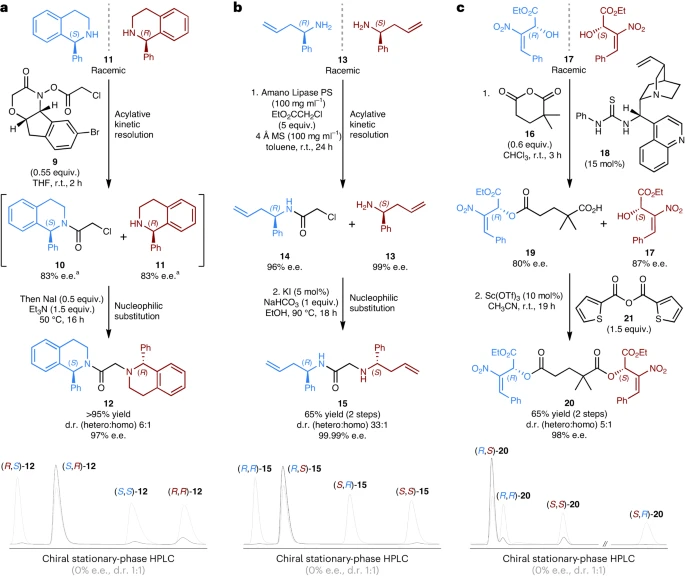
In conclusion:
To summarise, stereoretentive enantioconvergent reactions are a fundamental aspect of contemporary organic synthesis. They provide a flexible and potent set of tools for effective and specific chiral compound creation. Using the ideas of stereochemistry, catalysis, and molecular recognition, researchers have made a lot of progress in getting past long-standing problems and realizing the full potential of enantioconvergent transformations. Stereoretentive enantioconvergent reactions position themselves to have a growing influence on the future of chemistry and propel advancements in science and technology as we continue to explore the boundaries of chemical synthesis and molecular design.
Distinct Frequently Asked Questions:
1). What sets stereoretentive enantioconvergent reactions apart from other stereoselective transformations?
2). What is the role of catalysts in enabling enantioconvergent reactions?
3). Do stereoretentive enantioconvergent reactions have broad substrate applicability?
4). What are some important factors to consider while carrying out stereoretentive enantioconvergent reactions in a laboratory?
5). Is it possible to scale up stereoretentive enantioconvergent reactions for industrial applications?
For more chemistry blogs, visit chemistry Master

